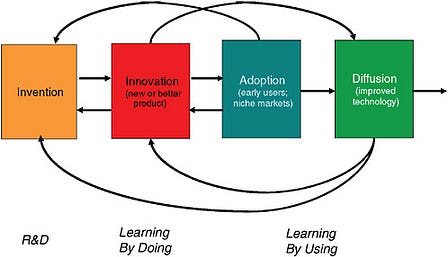Look, innovation is one of those words that everybody likes to throw around. It’s permeated the discourse in just about every organization in just about every field. Sometimes it’s used lazily, as a catch-all that doesn’t really catch much of anything at all. But there’s also a reason that it became so popular, to begin with. When real thought is put behind the word and the application of its meaning into an organization, tangible and impactful outcomes can be achieved. Let’s take a dive into how innovation can transform from a buzzword for your organization, to an asset.
A Definition We Can Work With
Before we go any further, it’s best to have a solid definition of innovation that speaks directly to us and the goals we’re hoping to achieve through innovation itself. Here’s the best we’ve been able to do so far:
Innovation is a continuing activity and a resource that can be drawn upon in an environment of change. Innovation is a new method, service, or product, and once you do it, it’s no longer new and again, there is something new to learn and explore. Innovation must be a core competency that requires a systems approach — factors, components, and practices — affecting how innovation occurs. Moreover, the action of innovation in and of itself continues to change. Once you can calculate one element of the innovation cycle, it becomes routine and has to be built upon as well and is therefore impossible to codify.
Innovation vs. Invention
Before there’s ever innovation, there’s invention. The invention is the seed from which innovation grows. The necessary first step before innovation can turn it into something greater entirely. A common framework for understanding this difference is the microprocessor. The invention of the microprocessor was, of course, monumental. But it was the ways that people were able to spin out countless products, processes, and services from this one invention that made it revolutionary. This is the power of innovation.
This is key knowledge for any organization. Innovation isn’t simply one moment, it’s not a static point in time where something happens and your work is done. True innovation is in the ability to iterate, to stay on the move and to continue to consider areas of improvement and act on them. Approaching innovation like an ongoing opportunity to evolve and get better is the first step to using it to your advantage.

So, How Do We Do It?
All of the above is all well and good, but it’s another thing entirely to be able to implement any of it. That requires a process that understands innovation in a way that goes beyond the buzzwords and nonsensical jargon.
Start with a period of reflection. No, we’re not saying you need to meditate on the workweek that was (though that could maybe help), we’re saying that it’s best to take a good, organized look back on the projects or tasks that you have been working on and write down all of the things that you got done.

From there, it’s time to experiment. Identify an experiment that you can imagine doing that would make accomplishing the above thing just 10% better next week. That’s it, only 10%. Nothing crazy, nobody’s saying you’ll have all of the answers right away, but instead think of ways to chip away while making real progress at the same time.
Then, make it happen through prototyping. Innovation really gets going when ideas leap from the mind or the page and start taking hold in the real world. Whether it’s conversational prototyping used to test key meetings, negotiations, and employee/er interactions, or physical methods to test interactions happening in the natural world or prototyping software and interactive spaces to test and re-risk digital experiences.
Following this process from reflection to experimentation, to paying it off with prototyping can help innovation take hold within your organization.

Bring it All Together
Nothing about the above means that these tactics, and any others you see fit, should be done entirely alone. In fact, that’s actually one way to stifle innovation, or at the very least make it a whole lot harder. One of the best ways to increase innovation within your organization is through collaboration.
The biggest innovations are done by teams, and lasting impacts are felt when there’s a plan in place that brings everyone together, no matter where in the organization they may fall. Providing a space to have individual voices and ideas heard in service of the organization as a whole is everything. It’s a shame that “teamwork makes the dream work” is such a terrible saying because… it’s pretty damn true.

A Reason to Innovate
Remember that “10% better” thing from before? About how nobody’s asking you to instantly make something wholly more efficient or productive, but to game plan and enact ways to make it just a bit better? That’s innovation in a nutshell. Even if you’re already excellent at something, there’s probably still room to become 10% better at that thing.
Searching for, and pouncing upon, those chances to become better is what innovation’s all about. What’s stopping your organization from going after its 10% boost?
Cal Bowman is the Vice President for Strategy and Innovation at Think|Stack, a human-centered technology company out of Baltimore, helping organizations transform.
About the Author

Cal Bowman
VP Strategy & Innovation



